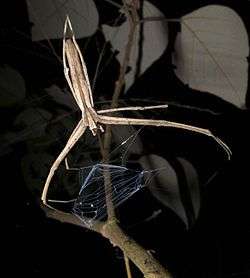Deinopoidea
| Deinopoidea | |
|---|---|
 | |
| Uloborus plumipes, Uloboridae | |
 | |
| Deinopis sp. with web | |
| Scientific classification | |
| Kingdom: | Animalia |
| Phylum: | Arthropoda |
| Subphylum: | Chelicerata |
| Class: | Arachnida |
| Order: | Araneae |
| Suborder: | Opisthothelae |
| Infraorder: | Araneomorphae |
| Superfamily: | Deinopoidea C.L. Koch, 1851[1] |
| Families | |
The Deinopoidea or deinopoids are group of cribellate araneomorph spiders that may be treated as a superfamily.[2] As usually circumscribed, the group contains two families: Deinopidae and Uloboridae.[1]
Some studies have produced cladograms in which the Deinopoidea are paraphyletic.[3] A review in 2014 concluded that "at this time the monophyly of Deinopoidea remains dubious".[4]
Characteristics
The group is characterized by the production of orb webs with catching threads of cribellate silk (i.e. silk made up of very fine threads produced by combing an initial thread using the spider's calamistrum). Uloborids spin vertical orb webs, very similar in shape to those made by araneids, such as the cross spider. Deinopids initially spin an orb web, which they then suspend between their front legs and use as a net to ensnare prey.[5][6]
Phylogeny
According to one hypothesis, the two groups in which orb-weaving occurs, the cribellate deinopoids and the ecribellate araneoids, make up a single monophyletic group, Orbiculariae, in which orb-weaving evolved. One hypothesis for the relationships involved is summarized in the cladogram below.[7][8]
| Entelegynae |
| |||||||||||||||||||||||||||
| |
An alternative view is that both the Deinopoidea and the Orbiculariae are paraphyletic (i.e. do not form a good taxa). Another hypothesis for the phylogeny of the Entelegynae is shown below (parentheses show the genera included in the study).[9]
|
Deinopoidea |
References
- 1 2 Dunlop, Jason A. & Penney, David (2011), "Order Araneae Clerck, 1757" (PDF), in Zhang, Z.-Q., Animal biodiversity: An outline of higher-level classification and survey of taxonomic richness, Zootaxa (3148), Auckland, New Zealand: Magnolia Press, ISBN 978-1-86977-850-7, retrieved 2015-10-31
- ↑ Griswold, Charles E.; Coddington, Jonathan A.; Hormiga, Gustavo & Scharff, Nikolaj (1998), "Phylogeny of the orb-web building spiders (Araneae, Orbiculariae: Deinopoidea, Araneoidea)", Zoological Journal of the Linnean Society, 123 (1): 1–99, doi:10.1111/j.1096-3642.1998.tb01290.x, ISSN 1096-3642
- ↑ Hormiga, Gustavo; Dimitrov, Dimitar; Lopardo, Lara; Giribet, Gonzalo; Arnedo, Miquel A. & Álvarez-Padilla, Fernando (2011), Tangled in a sparse spider web: single origin of orb weavers (PDF), retrieved 2015-09-24
- ↑ Hormiga, Gustavo & Griswold, Charles E. (2014), "Systematics, Phylogeny, and Evolution of Orb-Weaving Spiders", Annual Review of Entomology, 59 (1): 487–512, doi:10.1146/annurev-ento-011613-162046, PMID 24160416, p. 492
- ↑ Coddington, J.A. (1986), "The monophyletic origin of the orb web" (PDF), in Shear, W.A., Spiders: Webs, Behavior, and Evolution, Stanford University Press, pp. 319–363, ISBN 978-0-8047-1203-3, retrieved 2015-10-12
- ↑ Leong, T.M. & Foo, S.K. (2009), "An encounter with the net-casting spider, Deinopis species in Singapore (Araneae: Deinopidae)" (PDF), Nature in Singapore, 2: 247–255, retrieved 2015-09-28
- ↑ Coddington, Jonathan A. (2005), "Phylogeny and classification of spiders" (PDF), in Ubick, D.; Paquin, P.; Cushing, P.E. & Roth, V., Spiders of North America: an identification manual, American Arachnological Society, pp. 18–24, retrieved 2015-09-24
- ↑ Bond, Jason E.; Garrison, Nicole L.; Hamilton, Chris A.; Godwin, Rebecca L.; Hedin, Marshal & Agnarsson, Ingi (2014), "Phylogenomics Resolves a Spider Backbone Phylogeny and Rejects a Prevailing Paradigm for Orb Web Evolution", Current Biology, 24 (15): 1765–1771, doi:10.1016/j.cub.2014.06.034
- ↑ Bond et al. (2014), Fig S5.